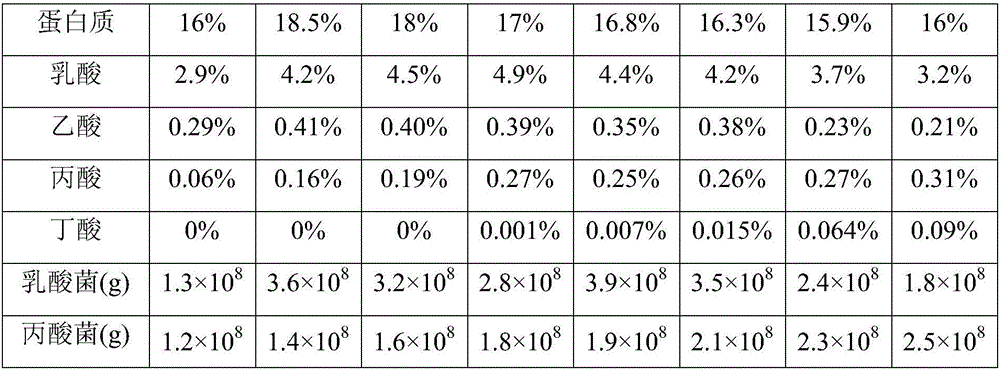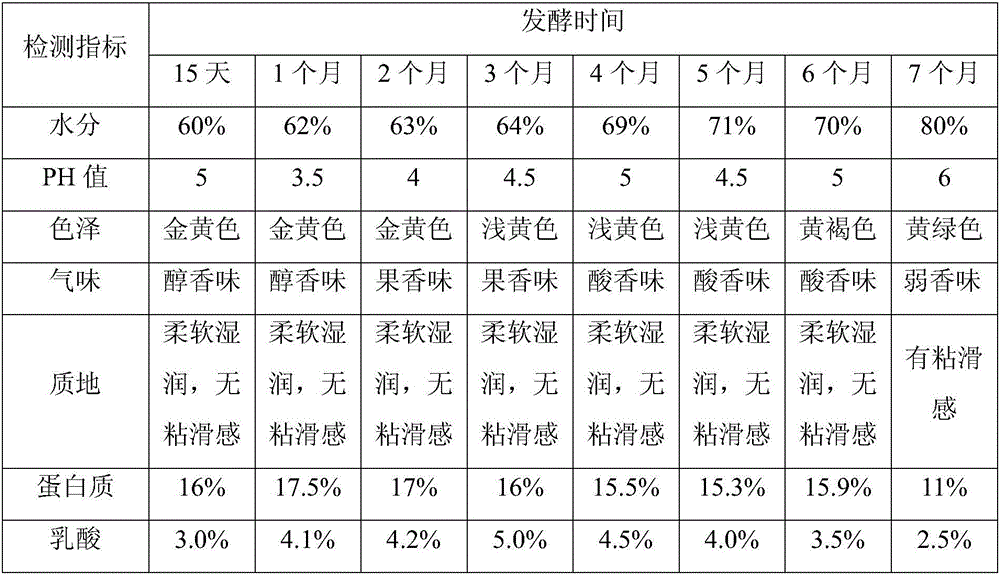Microbial fermenting feed for nursery pigs and preparation method thereof
A technology for fermented feed and nursery pigs, which is applied in the field of micro-storage fermented feed for nursery pigs and its preparation, can solve the problems of high disease susceptibility, impact on pork quality, pig output, intestinal burden, etc., so as to improve protein conversion, absorption and protection Feed quality and the effect of reducing environmental pollution
- Summary
- Abstract
- Description
- Claims
- Application Information
AI Technical Summary
Problems solved by technology
Method used
Image
Examples
Embodiment 1
[0043] Embodiment 1 A kind of micro-storage fermented feed for nursery pigs
[0044] 1. Formulation raw material composition
[0045] It consists of the following components by mass percentage: 20% of rapeseed stalks, 74.35% of cassava whole plant (including roots and stems and leaves), 0.3% of pulsatilla powder, 0.2% of microbial strains, 0.15% of cellulase, and 5% of table salt.
[0046] The microbial strains are a mixture of Lactobacillus plantarum, Lactobacillus casei, Lactobacillus Brucella and propionic acid bacteria; the cellulase is mainly endo-β-1,4-glucanase, exoglucanase Carbohydrases and β-glucosidases.
[0047] 2. Preparation method
[0048] S1. Collect the fresh rapeseed stalks after the rapeseed has been collected, dry naturally, remove the moldy parts, and require water
[0049] If the content is less than 15%, use a pulverizer to crush the fineness to 2-3cm long;
[0050] S2. Harvest the whole cassava plant, remove the dust, crush the stems and leaves to a...
Embodiment 2
[0058] Embodiment 2 A kind of micro-storage fermented feed for nursery pigs
[0059] 1. Formulation raw material composition
[0060] It consists of the following components by mass percentage: 15% of rapeseed stalks, 80% of whole cassava plants (including tubers and stems and leaves), 0.2% of Pulsatillae powder, 0.1% of microbial strains, 0.2% of cellulase, and 4.5% of table salt.
[0061] The microbial strains are a mixture of Lactobacillus plantarum, Lactobacillus casei, Lactobacillus Brucella and propionic acid bacteria; the cellulase is mainly endo-β-1,4-glucanase, exoglucanase Carbohydrases and β-glucosidases.
[0062] 2. The preparation method is the same as in Example 1.
[0063] 3. Quality inspection, as shown in Table 2, the micro-storage fermented feed for nursery pigs prepared by this method has a high quality within 6 months.
[0064] Table 2
[0065]
[0066]
Embodiment 3
[0067] Embodiment 3 A kind of micro-storage fermented feed for nursery pigs
[0068] 1. Formulation raw material composition
[0069] It consists of the following components in mass percentage: 25% of rapeseed stalks, 68% of cassava whole plant (including roots and stems and leaves), 0.4% of pulsatilla powder, 0.3% of microbial strains, 0.1% of cellulase, and 6.2% of table salt.
[0070] The microbial strains are a mixture of Lactobacillus plantarum, Lactobacillus casei, Lactobacillus Brucella and propionic acid bacteria; the cellulase is mainly endo-β-1,4-glucanase, exoglucanase Carbohydrases and β-glucosidases.
[0071] 2. The preparation method is the same as in Example 1.
[0072] 3. Quality inspection, as shown in Table 3, the micro-storage fermented feed for nursery pigs prepared by this method has a high quality within 5 months.
[0073] table 3
[0074]
[0075]
PUM
 Login to View More
Login to View More Abstract
Description
Claims
Application Information
 Login to View More
Login to View More - R&D
- Intellectual Property
- Life Sciences
- Materials
- Tech Scout
- Unparalleled Data Quality
- Higher Quality Content
- 60% Fewer Hallucinations
Browse by: Latest US Patents, China's latest patents, Technical Efficacy Thesaurus, Application Domain, Technology Topic, Popular Technical Reports.
© 2025 PatSnap. All rights reserved.Legal|Privacy policy|Modern Slavery Act Transparency Statement|Sitemap|About US| Contact US: help@patsnap.com



